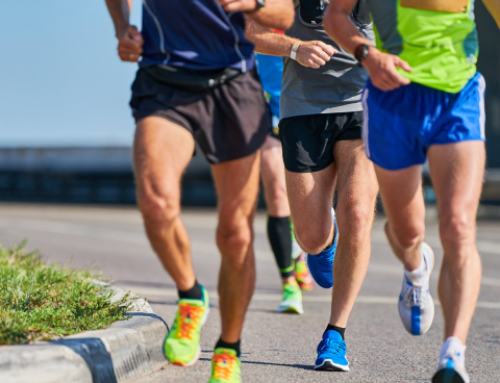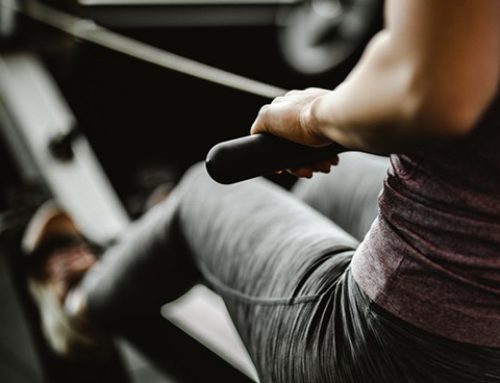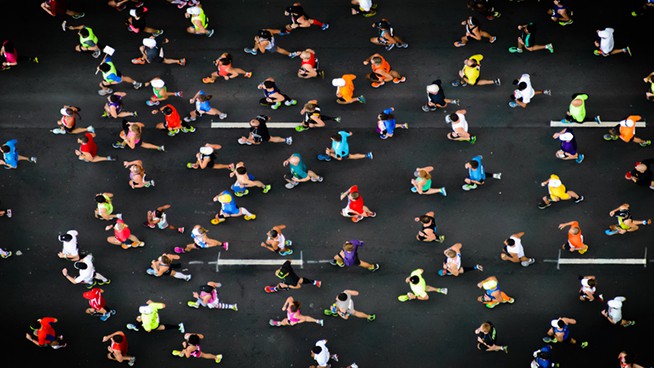Choose the Best Barefoot Running Shoes for You
Whether you’re a novice runner or an elite marathoner, choosing the right pair of shoes will keep you training optimally and help you reach your fitness goals. Barefoot running has risen in popularity in recent years, and many people are seeking its benefits. Learn more about the latest in shoe technology to make sure your next pair of running shoes will be the perfect fit.
Heel Strike
The biggest difference between traditional running shoes and barefoot models is the shift away from a built-up heel. (Read more about “drops” and “stack height.”) According to Danny Abshire, triathlete and renowned running coach, running with a heel strike form or gait is unnatural.1 Our brain thinks it’s safe to land on those soft heels; however, a heel-strike gait makes the foot and ankle more vulnerable to rotational forces and injury. Lightweight running shoes allow your feet to mimic the flexibility and motion of barefoot running to transfer downward energy into forward propulsion.
Running Performance
Training barefoot can significantly improve your sports performance. It allows you to use less energy and muscle power to run faster and with less risk of injury. Barefoot running shoes enhance your ability to land on your midfoot/forefoot, allowing your foot to flex, engage the arch and lock the ankle—and for your flexed knee to spring forward. Check out the videos below to view the impact a natural barefoot running technique can have on your performance and health.
This video illustrates a traditional heel striking form and the significant amount of force transferred to the body when the foot impacts the ground.
This video displays a barefoot running form and the reduced impact it has on the body when the foot lands.
Running Tips and Shoe Recommendations
When running with a natural midfoot stride, your body senses the ground the instant it touches down, putting you in the most efficient and effective position for the terrain you’re on. The running shoe you choose should allow for such biofeedback to happen.
Tip #1: Land gently. Get comfortable with your running shoes by training barefoot on sand or grass before moving to hard surfaces. Sensory feedback will tell you instantly if you are landing too hard.
Tip #2: Avoid over-striding. If your foot lands too far in front of your knee and hips, it adds stress to the calf muscles, Achilles tendon and arch of the foot.
Tip #3: Avoid heel striking. Practice landing on your forefoot by walking backward with a slight forward lean and gradually speeding up (making sure no obstacles are behind you). You can also walk or run uphill, which makes landing on the heel practically impossible.
Below are three great options for barefoot shoes.
Nike Free 3.0 V3
Nike has developed a running shoe designed to closely mimic the barefoot experience. One of their latest versions, Nike Free 3.0 V3, is extremely light (around seven ounces) and has deep cuts in the outsole to give your feet both flexibility and stability.
Newton MV2
The Newton shoe company does its own take on the barefoot running shoe. The MV2 racing flat is the lightest and most efficient natural running shoe in their line of trainers. With a ground-level profile, a weight of around 5.8 ounces, and a unique biomechanical sensor plate in the midsole, the MV2 gives the foot a quicker ground feedback sensation, promoting a fast-paced cadence.
Vibram Bikila
Vibram’s Five Fingers barefoot shoes are in a class by themselves. The Bikila is the company’s first model specifically designed to promote a natural and efficient midfoot/forefoot strike. It has a 4mm anatomical pod outsole that offers plenty of underfoot protection. It weighs in at six ounces and, when sized properly, should fit like a glove.
Transitioning to Barefoot Running Shoes
Your experience may be different, but I had a smooth transition from traditional running shoes to barefoot runners. I spent a few days each week running barefoot at the beach to condition myself to land naturally on my midfoot and avoid over-striding. It’s best to run barefoot in small doses at first, until you improve your body mechanics, teach yourself to land lightly on your midfoot/forefoot, and strengthen the muscles in your feet and ankles so you don’t rely on your lower- and upper-leg muscles to do so much work when your feet touch the ground. According to Mark Cucuzzella, M.D., a professor at the University of West Virginia and a competitive masters marathoner, the key to running injury-free is to focus on your form first, build stronger, more stable muscles and get shoes that work well for you.2
Sources:
1. Abshire, Danny, and Brian Metzler. Natural Running: The Simple Path to Stronger, Healthier Running. Boulder, Colo: VeloPress, 2010.
2. Dreyer, Danny, and Katherine Dreyer. ChiRunning: A Revolutionary Approach to Effortless, Injury-Free Running. New York: Simon & Schuster, 2009.
Photo: morguefile.com
Danny Vasquez, CSCS, is an amateur triathlete who work as a sports performance consultant and executive director of a nonprofit organization that uses sports to improve the lives of children and spread the message of peace. He earned his bachelor’s degree in kinesiology at California State University, Los Angeles and is actively pursuing a master’s degree in sports medicine.
RECOMMENDED FOR YOU
MOST POPULAR
Choose the Best Barefoot Running Shoes for You
Whether you’re a novice runner or an elite marathoner, choosing the right pair of shoes will keep you training optimally and help you reach your fitness goals. Barefoot running has risen in popularity in recent years, and many people are seeking its benefits. Learn more about the latest in shoe technology to make sure your next pair of running shoes will be the perfect fit.
Heel Strike
The biggest difference between traditional running shoes and barefoot models is the shift away from a built-up heel. (Read more about “drops” and “stack height.”) According to Danny Abshire, triathlete and renowned running coach, running with a heel strike form or gait is unnatural.1 Our brain thinks it’s safe to land on those soft heels; however, a heel-strike gait makes the foot and ankle more vulnerable to rotational forces and injury. Lightweight running shoes allow your feet to mimic the flexibility and motion of barefoot running to transfer downward energy into forward propulsion.
Running Performance
Training barefoot can significantly improve your sports performance. It allows you to use less energy and muscle power to run faster and with less risk of injury. Barefoot running shoes enhance your ability to land on your midfoot/forefoot, allowing your foot to flex, engage the arch and lock the ankle—and for your flexed knee to spring forward. Check out the videos below to view the impact a natural barefoot running technique can have on your performance and health.
This video illustrates a traditional heel striking form and the significant amount of force transferred to the body when the foot impacts the ground.
This video displays a barefoot running form and the reduced impact it has on the body when the foot lands.
Running Tips and Shoe Recommendations
When running with a natural midfoot stride, your body senses the ground the instant it touches down, putting you in the most efficient and effective position for the terrain you’re on. The running shoe you choose should allow for such biofeedback to happen.
Tip #1: Land gently. Get comfortable with your running shoes by training barefoot on sand or grass before moving to hard surfaces. Sensory feedback will tell you instantly if you are landing too hard.
Tip #2: Avoid over-striding. If your foot lands too far in front of your knee and hips, it adds stress to the calf muscles, Achilles tendon and arch of the foot.
Tip #3: Avoid heel striking. Practice landing on your forefoot by walking backward with a slight forward lean and gradually speeding up (making sure no obstacles are behind you). You can also walk or run uphill, which makes landing on the heel practically impossible.
Below are three great options for barefoot shoes.
Nike Free 3.0 V3
Nike has developed a running shoe designed to closely mimic the barefoot experience. One of their latest versions, Nike Free 3.0 V3, is extremely light (around seven ounces) and has deep cuts in the outsole to give your feet both flexibility and stability.
Newton MV2
The Newton shoe company does its own take on the barefoot running shoe. The MV2 racing flat is the lightest and most efficient natural running shoe in their line of trainers. With a ground-level profile, a weight of around 5.8 ounces, and a unique biomechanical sensor plate in the midsole, the MV2 gives the foot a quicker ground feedback sensation, promoting a fast-paced cadence.
Vibram Bikila
Vibram’s Five Fingers barefoot shoes are in a class by themselves. The Bikila is the company’s first model specifically designed to promote a natural and efficient midfoot/forefoot strike. It has a 4mm anatomical pod outsole that offers plenty of underfoot protection. It weighs in at six ounces and, when sized properly, should fit like a glove.
Transitioning to Barefoot Running Shoes
Your experience may be different, but I had a smooth transition from traditional running shoes to barefoot runners. I spent a few days each week running barefoot at the beach to condition myself to land naturally on my midfoot and avoid over-striding. It’s best to run barefoot in small doses at first, until you improve your body mechanics, teach yourself to land lightly on your midfoot/forefoot, and strengthen the muscles in your feet and ankles so you don’t rely on your lower- and upper-leg muscles to do so much work when your feet touch the ground. According to Mark Cucuzzella, M.D., a professor at the University of West Virginia and a competitive masters marathoner, the key to running injury-free is to focus on your form first, build stronger, more stable muscles and get shoes that work well for you.2
Sources:
1. Abshire, Danny, and Brian Metzler. Natural Running: The Simple Path to Stronger, Healthier Running. Boulder, Colo: VeloPress, 2010.
2. Dreyer, Danny, and Katherine Dreyer. ChiRunning: A Revolutionary Approach to Effortless, Injury-Free Running. New York: Simon & Schuster, 2009.
Photo: morguefile.com
Danny Vasquez, CSCS, is an amateur triathlete who work as a sports performance consultant and executive director of a nonprofit organization that uses sports to improve the lives of children and spread the message of peace. He earned his bachelor’s degree in kinesiology at California State University, Los Angeles and is actively pursuing a master’s degree in sports medicine.











